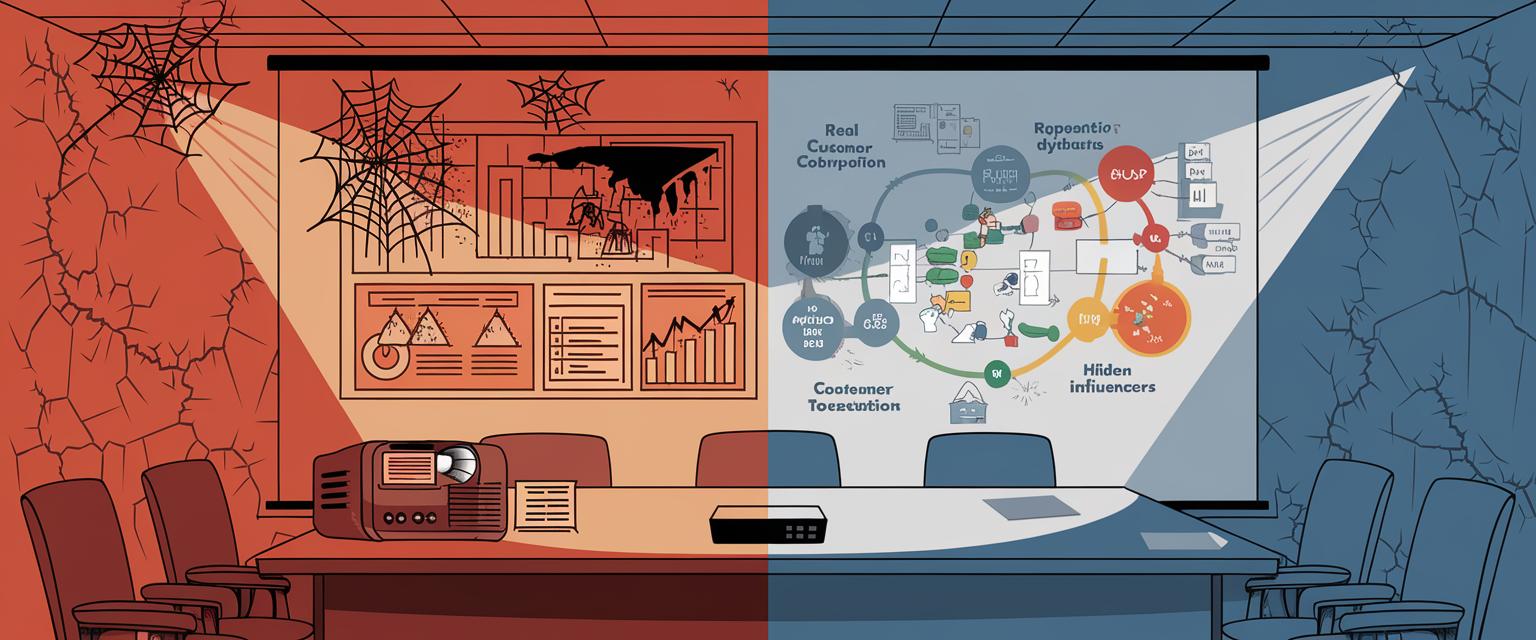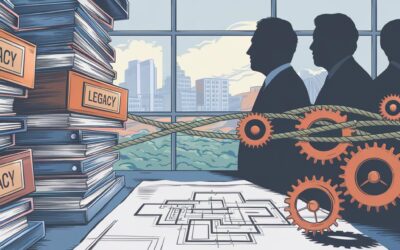B2B Customer Journey Mapping: Insightful Challenges Solved
Introduction: The Expensive Illusion of Knowing Your B2B Customer
Let’s cut through the noise: most B2B customer journey maps are expensive PowerPoint decks gathering digital dust. Companies invest lakhs in mapping exercises that deliver more consultant billable hours than actionable insights. The uncomfortable truth? Your marketing team thinks they understand the journey. Your sales team disagrees. And your customers experience something entirely different from what either team believes.
Customer journey mapping for B2B isn’t failing because the concept is flawed. It’s failing because we’ve turned a brutally practical operational tool into a theoretical exercise detached from revenue reality. After running transformation projects across nine sectors, I’ve seen the gap between journey maps on slides and what actually happens when your customer tries to buy from you.
- Most B2B journey maps miss 40% of actual touchpoints
- Decision-making units are far more complex than your CRM suggests
- Indian SMEs waste resources by copying enterprise mapping approaches
- The gap between sales and marketing creates journey blindspots
Table of Contents
- The Truth Behind Failed B2B Journey Mapping
- Four Components That Actually Matter in B2B Journey Mapping
- The No-Nonsense B2B Mapping Process for Indian SMEs
- Reality Check: Solving the Challenges That Derail B2B Journey Maps
- FAQ
- Conclusion
The Truth Behind Failed B2B Journey Mapping
When a B2B customer journey mapping initiative fails to deliver results—which happens in 7 out of 10 cases I’ve audited—the root causes are surprisingly consistent. And none of them involve “not having the right template” or “using the wrong software.”
The Politics of Purchase
Your prospect’s internal politics shapes their buying journey more than your marketing. During my time at Polycab, we discovered that 62% of our enterprise deals were influenced by hidden stakeholders who never appeared in sales meetings. One project worth ₹2.8 crores was stalled for three months because a junior engineer—who wasn’t even on our radar—had concerns about compatibility with existing systems.
Most journey maps track titles, not influence. The VP may sign the check, but that assistant manager might be the one truly controlling the process.
The Data Collection Delusion
Your CRM data is capturing maybe 30% of the actual customer journey. The rest happens in WhatsApp messages, LinkedIn exchanges, industry events, and casual conversations that never make it into your system.
When we restructured the sales approach for a materials handling company, we found their formal touchpoints (calls, meetings, proposals) represented just 4 of the 14 actual interactions that influenced purchase decisions. The other 10? Everything from the receptionist’s greeting to how quickly email queries received responses.
The Marketing-Sales Disconnect
Your marketing team is measuring website engagement while your sales team is promising delivery timelines neither of you can track properly. I’ve yet to see a B2B organization where marketing and sales agree on what the customer journey actually is.
At a midsize adhesives manufacturer, marketing created elaborate journey maps based on digital touchpoints while completely missing that 80% of customers made decisions based on physical product samples and technical support responsiveness—both managed by sales with zero visibility to marketing.
Four Components That Actually Matter in B2B Journey Mapping
Forget the 12-stage models you’ve seen in consultancy decks. For Indian B2B SMEs, there are four components that actually move the needle on customer experience journey development.
1. Decision-Making Units, Not Just Personas
Stop creating isolated buyer personas. Map the entire Decision-Making Unit (DMU) and how they interact internally. When we transformed a chemical company’s approach, we discovered their buying process involved an average of 5.3 stakeholders with conflicting priorities.
For each role in the DMU, document:
| DMU Element | What to Map |
|---|---|
| Role & Authority | Formal title vs. actual influence (often different) |
| Technical Requirements | Specific criteria they evaluate you against |
| Personal Incentives | What helps/hurts their career or department |
| Information Sources | Where they get trusted information (rarely your website) |
A manufacturing client discovered their biggest blocker wasn’t the purchasing manager but the operations team afraid of integration issues. Addressing this hidden concern increased their close rate by 41%.
2. Content Alignment That Matches Reality
The B2B content calendar model is broken. Your prospects don’t consume content sequentially like your marketing plan suggests. Instead of awareness-consideration-decision content buckets, map content to specific questions and objections that arise at different touchpoints.
When revamping Emami’s B2B approach, we found that 72% of their marketing content went unused by sales teams because it answered questions prospects weren’t actually asking. Instead, we built simple, question-specific content pieces the sales team could deploy at exactly the right moment.
3. Competitive Positioning at Each Stage
Your customers aren’t evaluating you in isolation. At each journey stage, map how competitors are positioning themselves on the specific criteria that matter at that point.
During the IPO phase at Polycab, we mapped customer journeys against our top three competitors at each stage—discovering that while we won on product quality, we lost deals during the evaluation stage due to slower sample delivery and post-purchase documentation. Fixing these specific competitive gaps improved conversion by 23%.
4. Internal Process Alignment
The customer experience you deliver is only as good as your internal processes allow. For each customer touchpoint, map the internal process that supports it and identify the gaps.
A mid-sized IT services firm discovered their 3-week proposal turnaround time (compared to competitors’ 1-week) wasn’t due to thoroughness but to an approval process requiring six signatures—when their competitors required just two. Streamlining this delivered immediate results.
The No-Nonsense B2B Mapping Process for Indian SMEs
Forget the enterprise playbooks. Indian SMEs need a practical approach that acknowledges your constraints and the unique dynamics of the Indian B2B market.
Phase 1: Reality Check (Not Market Research)
Start with brutal honesty, not aspirations. Analyze your last 10 won deals and 10 lost deals. What actually happened? Document:
- First contact point (rarely what your marketing assumes)
- Total time from first contact to decision
- Number of people involved on customer side
- Questions asked at each stage
- Objections raised (stated and unstated)
- Information requested but not provided
A building materials client discovered their assumption that architects were the primary decision-makers was wrong—contractors were actually driving 60% of specifications, completely inverting their sales approach.
Phase 2: Front-Line Knowledge Extraction
Your sales team knows more about the actual customer journey than your marketing consultants ever will. Create a structured process to extract this knowledge.
Run workshops where sales teams map out what really happens in deals. Incentivize honesty by focusing on “what customers actually do” rather than “what sales is doing right/wrong.” One manufacturing client uncovered that customers were performing unofficial product testing with competitors—a critical journey step they were completely missing.
Phase 3: Map the 5 Critical B2B Journey Phases
For SMEs, simplify to what matters. Focus on mapping these five phases:
| Journey Phase | What SMEs Must Map |
|---|---|
| Problem Recognition | Triggers that cause prospects to enter market (rarely your marketing) |
| Supplier Identification | How they build their consideration set (industry networks, referrals) |
| Evaluation Process | Formal and informal assessment methods they use |
| Purchase Negotiation | Decision criteria beyond price (payment terms, support, guarantees) |
| Implementation & Expansion | How first experience shapes future buying (track NPS drivers) |
During my time at Tata Teleservices, we discovered the evaluation process for enterprise connectivity included an unofficial “reference check” with peer companies that wasn’t appearing in any of our journey documentation. Once identified, we built a reference management program that increased conversion by 26%.
Phase 4: Identify and Close Process Gaps
The journey map is worthless without action. For each touchpoint, identify:
- Who owns this interaction internally
- What systems/processes support it
- How performance is currently measured
- Top 3 failure points (be brutally honest)
- Required fixes (process, people, technology)
An industrial equipment client realized their technical support response time—the #1 factor in customer satisfaction—wasn’t being measured or incentivized at all. Implementing a simple SLA improved retention by 18%.
Reality Check: Solving the Challenges That Derail B2B Journey Maps
B2B customer engagement fails at predictable points. Here’s how to solve the real challenges that derail your mapping efforts.
Challenge 1: The Data Integration Nightmare
Every SME struggles with fragmented customer data across CRM, email, accounting systems, and WhatsApp conversations. This creates blindspots in your journey mapping.
Practical Solution: Skip the expensive “unified platform” trap. Instead, create manual data consolidation checkpoints for key accounts. At a chemicals client, we implemented simple weekly “customer journey update” meetings where sales, service, and accounting shared customer status updates from their respective systems. Low-tech but immediately effective.
As one client’s CEO admitted: “We spent ₹60 lakhs on CRM integration trying to solve what a 30-minute weekly meeting fixed.”
Challenge 2: The “Too Many Touchpoints” Problem
Indian B2B buying processes typically involve 40+ touchpoints across digital and physical channels. Trying to map every interaction leads to analysis paralysis.
Practical Solution: Identify and obsess over the 5-7 “moment of truth” touchpoints that actually determine success. At Somany Ceramics, we discovered that despite dozens of interactions, just three moments determined 80% of purchase decisions: sample quality, technical specification clarity, and credit term flexibility.
Focus your journey mapping resources on these critical points rather than trying to document every email and phone call.
Challenge 3: Sales Resistance to Structured Processes
Your veteran sales team believes their relationships transcend “process” and resist attempts to map or standardize customer journeys.
Practical Solution: Start with wins, not compliance. At an industrial adhesives company, we began by mapping only the post-sale journey, demonstrating how structured processes improved customer retention. Once sales saw the benefits, they became advocates for mapping the pre-sale journey too.
The key insight: sales teams resist journey mapping because they think it’s about controlling them, not helping them win.
Challenge 4: The “Missing Middle” in B2B Journeys
Most B2B journey maps detail the beginning (lead generation) and end (closing) but miss the critical middle where deals are actually won or lost.
Practical Solution: Map your competitors’ strengths at each journey stage. At Polycab, we created a competitive scoring matrix for each journey phase, revealing we were losing ground during the “evaluation” stage when customers were comparing technical specifications—despite advantages in other areas.
This revealed an urgent need to improve our technical documentation and specification sheets—a quick fix that improved conversion rates significantly.
FAQ
How to create a customer journey map for a B2B SME?
Start with sales reality, not marketing theory. Document your last 10-15 deals (won and lost), identify the actual steps customers took, map the decision-makers involved at each stage, and connect each touchpoint to your internal processes. Keep it simple—a spreadsheet with stages, touchpoints, owners, and gaps is more valuable than an elaborate visual with no operational insight. The most effective B2B journey maps I’ve implemented fit on two pages and focus on fixing specific conversion blockers.
What are the key touchpoints in a B2B customer journey?
While every industry differs, the universal critical touchpoints include: initial needs assessment conversations, technical specification sharing, pricing/proposal delivery, sample or demo experience, reference validation, implementation/onboarding, and first support request. These moments disproportionately shape perception and outcomes. According to research by Mountain.com, 74% of B2B purchase decisions are made based on the quality of these specific interactions rather than overall brand perception [Mountain.com, 2023].
How do you measure the effectiveness of a B2B customer journey map?
A journey map is effective when it drives revenue metrics, not when it looks pretty. Measure: (1) Conversion rate improvements at key funnel stages, (2) Reduction in sales cycle length, (3) Increase in deal size, (4) Improvement in customer retention, and (5) Reduction in support escalations. If your journey mapping isn’t moving these metrics, you’re creating documentation, not driving improvement.
Why aren’t we talking about the handoff gap between marketing and delivery teams?
The most dangerous journey breakdown happens when marketing promises what operations can’t deliver. The gap between sales commitments and actual delivery capabilities is the #1 reason for B2B customer churn. Your journey map must explicitly document what’s promised at each stage and how those promises translate to operational requirements. This alignment is where most Indian B2B SMEs fail—creating customer experience gaps that no amount of relationship management can overcome.
Conclusion
Customer journey mapping for B2B isn’t about creating pretty visualizations or theoretical frameworks. It’s about honest operational diagnosis and targeted improvement. The companies winning in this space aren’t using sophisticated mapping software—they’re simply better at identifying and fixing the specific breakdowns that lose them business.
The hard truth most consultants won’t tell you: a B2B customer journey is messy, non-linear, and driven by human factors no flowchart can capture. The most valuable journey maps don’t document the ideal process but rather expose the brutal reality of where you’re failing customers.
In my 25 years across sectors, I’ve never seen a beautiful journey map outperform an ugly but honest one. Stop mapping what should happen and start fixing what actually does.
Your customers aren’t following your carefully designed journey. They’re creating their own. Your job isn’t to control it but to understand it.
Ready to move beyond journey mapping theater to revenue-driving reality? Book a boardroom diagnostic with Crescentia where we’ll identify your critical journey gaps and build a practical roadmap to fix them.






